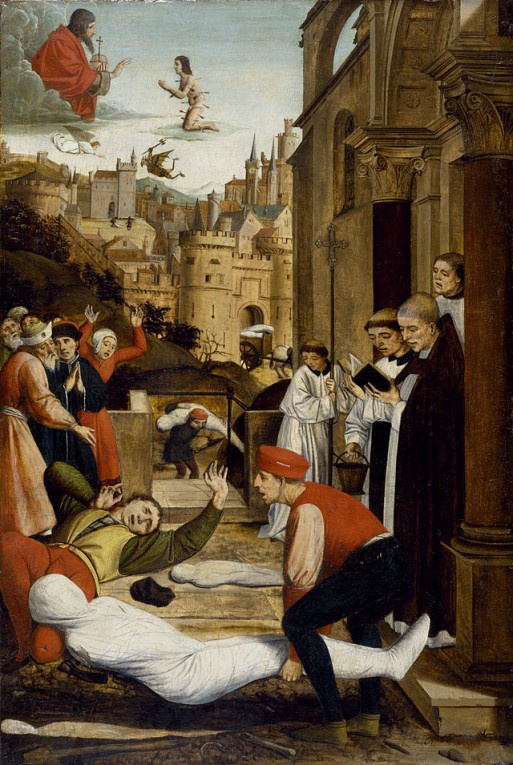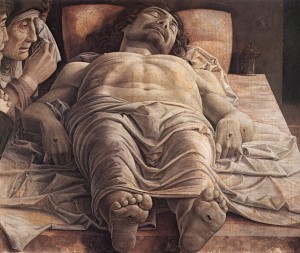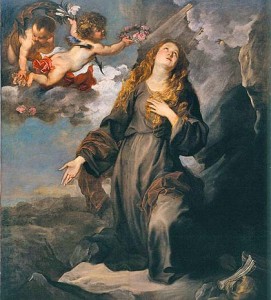
“Saint Sebastian Interceding for the Plague Stricken” Josse Lieferinxe (1497-1499)
(Credit: Wikipedia.org)
The cultural bloom of the Italian – and wider European – Renaissance was fed by the shadow of death. The bubonic plague was carried by fleas traveling on rodents, who then hitched rides along the expanding trade routes in the 1300s. The plague periodically wiped out large swaths of the European population for the next 400 years. We can surely call that a reign of terror.
Yet, we look to this point in Western history as the foundation and flowering of what we celebrate as truth and beauty in the Western world. When you consider the deeply helixed connection between life and death, the ripeness of Renaissance art in the midst of such a deep cultural confrontation with death comes into a clearer frame.
The master artists of this time were keenly aware of the strength and fragility of the human body and spirit. They painted beautifully rendered bodies, draped with flesh that echoes the velvety robes that roll from them. They are thick-boned and earthly, often turning their resigned yet imploring faces to the heavens.
Flemish painter Anthony Van Dyck lived in Italy as the region experienced waves of epidemics; one in particular decimated 60% of the population in Sicily. An exhibition of his work, aptly titled “Van Dyck in Sicily: 1624-1625 Painting and the Plague” covers the rich connection between this artist’s work and a keen sense of sudden, disease-wrought death.
In Van Dyck’s painting, “Saint Rosalie Crowned with Roses by Two Angels,” Saint Rosalie brings one hand to her heart, as her other hand rests on an upside down human skull. Her body faces us as she turns her face upwards.
Her uplifted gaze, her connection to her own heart and spirit and her direct contact with physical remains speaks to Van Dyck’s framing of the saint as deeply steeped in the knowledge of life and death, light and dark, spirit and matter.
Her uplifted gaze, her connection to her own heart and spirit and her direct contact with physical remains speaks to Van Dyck’s framing of the saint as deeply steeped in the knowledge of life and death, light and dark, spirit and matter. In this awareness, she is crowned a saint, poised between heaven and earth, here to help those who may soon be bones.
In 1694, St. Rosalie was said to have appeared to a sick woman and a hunter in Palermo, Italy, while the town was in the thick of plague. She requested that her remains be retrieved from the cave she died in and put on procession. Once her remains were located and carried through Palermo three times, it was claimed that the plague lifted its grip on the city. The procession became a festival that is still celebrated in Palermo today, on July 15th, called festino.
Side note: William Buckland apparently examined the remains of St. Rosalie and determined they were the bones of a goat. We may blame rodents for the plague, but we can evidently thank goats for saving us from it.
Van Dyck’s other paintings of Saint Rosalie from his time in Italy (and there are several) follow a similar visual path. She stands on the earth and connects with the heavens, beseeching the spiritual world for help on the physical plane. Either one or both hands touch the earth, and bones are often found around her feet.
The particularly human knowledge of self also comes with it the painful awareness of loss of self at the hands of that oh-so-pernicious force of death — death of both ourselves and our loved ones. From the intensity of this knowledge flowers so much beauty. Our brain’s deep, emotional crenulations are formed just as much by the dark as they are the light. Renaissance painters seemed to intuit this knowledge, steeped as they were in the magnificent (if also pestilent) forces beyond our human control.

 Fed by the Shadow of Death
Fed by the Shadow of Death





 Forest Bathing Eases Grief by Soaking in Nature
Forest Bathing Eases Grief by Soaking in Nature
 The Spiritual Symbolism of Cardinals
The Spiritual Symbolism of Cardinals
 Meaning-Focused Grief Therapy: Imaginal Dialogues with the Deceased
Meaning-Focused Grief Therapy: Imaginal Dialogues with the Deceased














